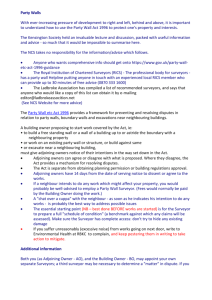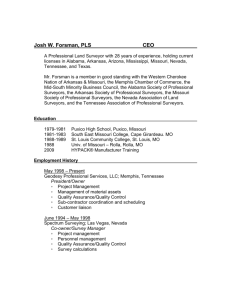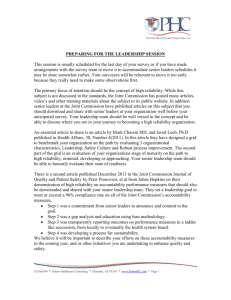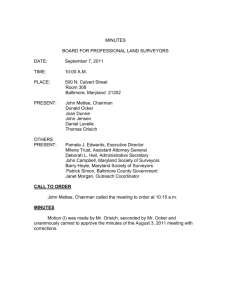A Principal Component Analysis of Skills and Competencies
advertisement
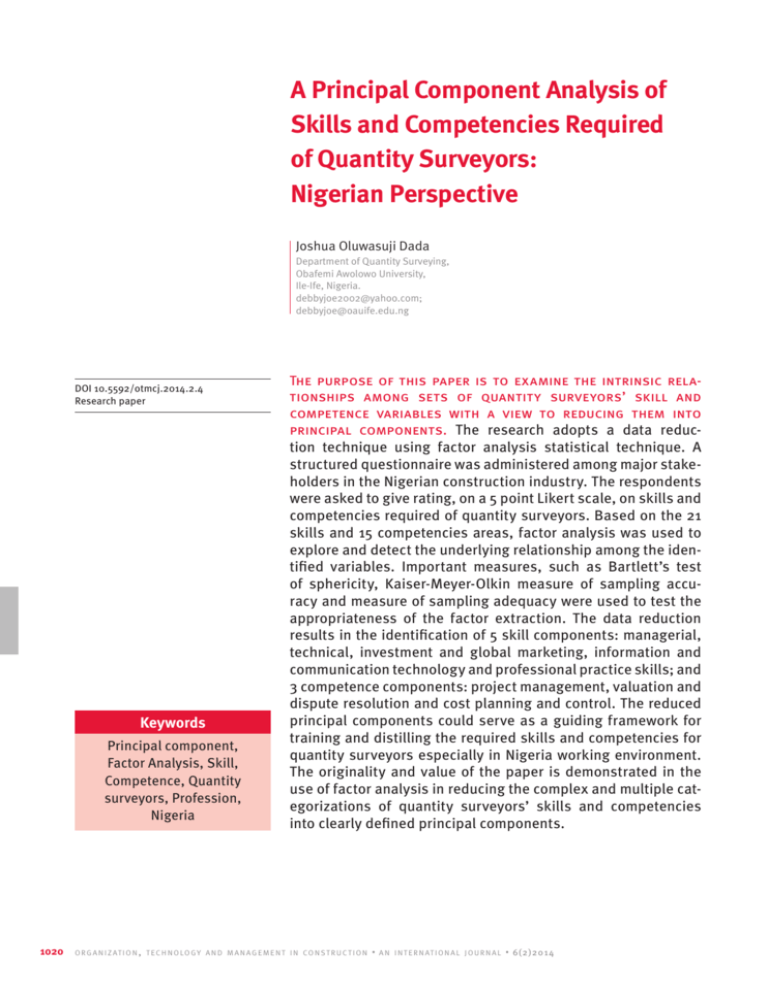
A Principal Component Analysis of Skills and Competencies Required of Quantity Surveyors: Nigerian Perspective Joshua Oluwasuji Dada Department of Quantity Surveying, Obafemi Awolowo University, Ile-Ife, Nigeria. debbyjoe2002@yahoo.com; debbyjoe@oauife.edu.ng DOI 10.5592/otmcj.2014.2.4 Research paper Keywords Principal component, Factor Analysis, Skill, Competence, Quantity surveyors, Profession, Nigeria 1020 The purpose of this paper is to examine the intrinsic relationships among sets of quantity surveyors’ skill and competence variables with a view to reducing them into principal components. The research adopts a data reduction technique using factor analysis statistical technique. A structured questionnaire was administered among major stakeholders in the Nigerian construction industry. The respondents were asked to give rating, on a 5 point Likert scale, on skills and competencies required of quantity surveyors. Based on the 21 skills and 15 competencies areas, factor analysis was used to explore and detect the underlying relationship among the identified variables. Important measures, such as Bartlett’s test of sphericity, Kaiser-Meyer-Olkin measure of sampling accuracy and measure of sampling adequacy were used to test the appropriateness of the factor extraction. The data reduction results in the identification of 5 skill components: managerial, technical, investment and global marketing, information and communication technology and professional practice skills; and 3 competence components: project management, valuation and dispute resolution and cost planning and control. The reduced principal components could serve as a guiding framework for training and distilling the required skills and competencies for quantity surveyors especially in Nigeria working environment. The originality and value of the paper is demonstrated in the use of factor analysis in reducing the complex and multiple categorizations of quantity surveyors’ skills and competencies into clearly defined principal components. o r g a n i z at i o n , t e c h n o l o g y a n d m a n a g e m e n t i n c o n s t r u c t i o n · a n i n t e r n at i o n a l j o u r n a l · 6(2)2014 INTRODUCTION While skill can be defined as proficiency or ability acquired or developed through training or experience, Stewart and Hamlin (1992) defined competence as something which a person who works in a given occupational area should be able to do. Holmes and Joyce (1993) viewed competence as a description of an action, behaviour or outcomes which a person should be able to demonstrate, or the ability to transfer skills and knowledge to new situations within the occupational area. Babalola (2009) while relating this to quantity surveying profession viewed a competent quantity surveyor as a person who is expected to possess a range of skills, knowledge and understanding and be able to apply these skills and knowledge in a range of context and organization. Formal measures of skill and competence require definition and classification, type and extent. However, the general literature on quantity surveying skill and competence illustrates a multiplicity of perspectives. A review of the various classifications and definition of skill and competence reveals that they are very much at variance. There is duplication of categorization and overlapping of definitions. Consequently, skill and competence classification and adoption are difficult to compare precisely because of diverse definitions. This study attempts to make a useful contribution in this context. The study, which is a follow up to an exploratory survey that investigated the attributes of quantity surveyors skills and competencies (findings reported in Dada and Jagboro, 2012), used the principal component analysis to explore and detect the underlying relationship among the identified skills and competencies required of quantity surveyors. The study aims at reducing the complex and multiple categorizations of the identified skills and competencies required of quantity surveyors into clearly defined principal components. j. o. dada · Literature review Quantity Surveyors’ skill and competence The RICS (1998) sets out the requirements and competencies for assessment of professional competence by listing the competencies required of quantity surveyors in three categories: basic competence, core competence and optional competencies. The basic skills are common to all construction professionals under RICS structure; the core skills are uniquely required of quantity surveyors, while the optional competencies reflect areas of specialization or future career diversification. The Pacific Association of Quantity Surveyors (PAQS) in response to the urgent need of quantity surveyors to reform, developed and implemented in 2001 eight basic skills requiring all quantity surveyors/cost engineers belonging to the institute in Japan, Malaysia, Singapore, Honk Kong, Australia, New Zealand, Fiji and Sri Lanka to comply with. These are: Quantification/Measurement, Communication Skills, Personal and Interpersonal Skills, Business and Management Skills, Professional Practice, Computer and Information Technology, Construction Technology, Construction Law and Regulation (PAQS, 2001). Githaiga (2004) grouped the experience of the services that quantity surveyors render into budgeting and estimating. The author further highlighted new areas of diversification where we have opportunity and challenges as: development appraisal, pre-contract cost control, taxation planning, contract administration, disputes, litigation and arbitration, technical auditing, valuation for fire insurance, fire loss adjustment, maintenance management schedule of condition and dilapidation, project management, research and development and overseas works. Nkado and Meyer (2001), in their study, carried out a survey of quantity surveyors’ professional practice in South Africa and provided a relative importance of skills and competencies required for quantity surveying services. The results from the study presented a long list of 23 competence areas. Babalola (2009) examined the core competencies of quantity surveyors in cost management and administration of electrical engineering services. This study revealed the relevant competencies expected of quantity surveyors and categorized them in the area of strength, weakness, opportunity and threats. According to Leveson (1996), quantity surveying competencies lie in the financial and contractual control of the building project as well as the development of soft skills. The basic skills form the platform from which a competent quantity surveyor can develop and these are integral part of the various units of competence. Crafford and Smallwood (2007) in their study, based on client perception, came up with thirty three competencies. From the review carried out, the various studies have, no doubt, contributed significantly to the concept of skill and competence required of quantity surveyors. However, there is no clearly defined focus for these skill and competence requirements. Subsequently, Dada and Jagboro (2012) in their study on an exploratory survey that investigated the attributes of quantity surveyors skills and competencies identified twenty one skills and fifteen competence areas. The identified twenty one skill variables are: computer literacy, building engineering, information technology, economics, measurement/quantification, knowledge of civil/heavy engineering, professional practice, construction law, interpersonal skill, knowledge of mechanical and electrical services engineering, financial skill and leadership skill, communication skill, managerial skill, marketing/business skill, knowledge about international a p r i n c i p a l c o m p o n e n t a n a ly s i s o f s k i l l s a n d c o m p e t e n c i e s r e q u i r e d o f q u a n t i t y s u r v e y o r s . . . · pp 1020 - 1032 1021 trading, investment analysis, mapping/surveying, actuarial science, gas/petrochemical engineering and solid mineral engineering. The identified fifteen competence variables are: cost planning and control, estimating, construction procurement system, contract documentation, contract administration, project management, feasibility and viability studies, valuation, financial management, development economics, risk management, life cycle costing, facility management, arbitration/dispute resolution and economic management of urban infrastructure. The Concept and Theory of Factor Analysis Factor Analysis is a statistical technique used to identify a relatively small number of factors that can be used to represent relationships among sets of many inter-related variable. Ahadzie (2007) and Owusu and Badu (2009) described it as a useful analytical tool for finding cluster of related variables and thus ideal for reducing a large number of variables into a more easily understood framework. According to Li, (2003), the mathematical model for factor analysis appears somewhat similar to a multiple regression equation where each variable is expressed as a linear combination of factors which are not actually observed. In general, the model for the standardized variable is written as: Xi = Ail F1 + Ai2F2 +... + Ak F k+ Ui Where the F ’s are the common factors, the U unique factor, and the A’s are the coefficient used to combine the k factors. The unique factors are assumed to be uncorrelated with each other and with the common factors. The general expression for the estimate of the jth factor, F j is Σ F j= Wjy Xi = Wji X1+Wj2 X2+... + Wjp Xp 1022 where W i ’s are known as factor score coefficients, and p is the number of variables. Factor analysis usually proceeds in four steps: In the first step, the correlation matrix for all variables is computed. Variables that do not appear to be related to other variables can be identified from the matrix and associated statistics. For the second step, factor extraction – the number of factors necessary to represent the data and the method for calculating them is determined and it is called “factor extraction”. The third step focuses on transforming the factors to make them more interpretable. The fourth step compute scores for each factor in each case. These scores can then be used in a variety of other analysis (Li, 2003). Research methodology In this research, data reduction principle was used in exploring the underlying relationship among the identified quantity surveyors’ skill and competence variables within the Nigeria context. Survey method was used in eliciting necessary data for the study. The designed structure questionnaire was pre-tested to ensure the appropriateness of the questions in terms of rhetoric and understanding of meanings prior to sending out the final draft to the respondents. The respondents’ choices of answers ranged on a 5- point Likert scale from least favourable to most favourable. The study population within the context of the study is a database of relevant stakeholders in the construction industry. The first group was the professional quantity surveyors. The second group comprised the co- professionals and for this group, the views of architects, structural engineers and builders, who were found to have direct dealings with quantity surveyors on construction projects, were obtained. The last group was the client organizations who benefits mostly from the services o r g a n i z at i o n , t e c h n o l o g y a n d m a n a g e m e n t i n c o n s t r u c t i o n · a n i n t e r n at i o n a l j o u r n a l of quantity surveyors. The database of these three groups constituted the sampling frame for the study. Stratified and random sampling techniques were adopted in the selection of the respondents. In order to determine a suitable sample size for the professionals, the total population was obtained from the list of registered professionals published by the respective professional bodies. In selecting appropriate sample size from the lists, the Mendenhall et al (1971) formula for calculating sample size was used. Currently the total number of registered quantity surveyors, architects, engineers and builders in the study area is 719, 672, 487 and 379 respectively. Substituting these values into the formula gives 257 quantity surveyors, 251 architects, 220 engineers and 195 builders. Random sampling method was thereafter used in selecting the respective numbers. For the client organisations, there is no published list that can be employed. Thus, it was not possible to have an exact sampling frame. As such, purposive sampling method was used in obtaining a sample size of 100 public and private client organisations. A total numbers of one thousand and twenty three questionnaires were sent out to the respondents based on the determined sample size and a total number of four hundred and forty five completely filled (appropriate for analysis) questionnaire were returned. This represents 46.5% of the total number of questionnaire administered. This considered adequate considering the submission of Moser and Kalton (1979) that the result of a survey would be taken as biased and of little value if the return rate were lower than 30 – 40%. Akintoye and Macleod (1997) also supported the view. In exploring the underlying relationship among the identified quantity surveyors’ skill and competence variables, factor analysis statistical technique was used to categorize the identified variables into principal components. · 6(2)2014 Various important measures, such as Bartlett’s test of sphericity, KaiserMeyer-Olkin (KMO) measure of sampling accuracy and Measure of Sampling Adequacy (MSA) were used to test the appropriateness of the factor extraction. Results and Discussions Principal Component analysis of Quantity Surveyors’ Skill variables The correlation matrix of the 21 variables constituting the skills required by quantity surveyors is shown in Table 1. Since one of the goals of factor analysis is to obtain factors that help explain this correlation, the variables must be related to each other for the factor model to be appropriate. If the correlation between the variables is small, it is unlikely that they share common factors (Nourisis, 1992). The value of the test statistics for sphericity is large (Bartlett’s test of sphericity = 4.370E3) and the associated significance is small (p = 0.000), suggesting that the population correlation was not an identity matrix. Observation of the correlation matrix show that all the items listed have significant correlation at the 5% level, suggesting no need to eliminate any of the variables for the principal component analysis. The value of the KMO statistics is 0.858 and it is considered satisfactory for factor analysis. The anti image correlation matrix (Table 2) also showed that the MSA of all the factors lie between the range of 0.309 and 0.626. The next steps are factor extraction and rotation, to obtain reduced numbers of factors to represent the 21 variables, in order to achieve easy interpretation. Initial matrix and rotated matrix results are shown in Table 3 and Figure 1. Sixty six percent of the total variance is attributable to the first five items. The remaining sixteen items together accounts for only 34% of the variance. Thus, a model with five j. o. dada · items may be adequate to represent the skills required of quantity surveyors. The factor grouping based on the varimax rotation is shown in Table 4. Each variable weighs heavily on to only one of the factors, while the loading on each factor exceeds 0.50. Each component is labeled and interpreted as follows: Component 1 - managerial skill, Component 2 – technical skill, Component 3 – investment and international trading, Component 4 – Information and communication technology and Component 5 - Professional practice. The label given to each component was generated based on the interrelated characteristics and coupled with the value of loading. Component 1 – Managerial Skill This principal factor accounts for 17.25% of the observed total variance and it contains eight items. The items are: marketing/business skill (sig. = 0.595), leadership skill (sig. = 0.770), managerial skill (sig. = 0.793), interpersonal skill (sig. = 0.757), communication skill (sig. = 0.677), mapping/surveying (sig. = 0.508) and construction law (sig. = 0.556). Those that received higher loading are: managerial, interpersonal, leadership and communication skills and are regarded very necessary skills for any profession to thrive in the emerging economy. This findings support the position of Westcott and Burnside (2003) that “management is a key area, which education and training can help to address”. In addition to the provision of “technical professional services by quantity surveyors, the increasing development of management consultancy-type services can be seen as a means of providing marketdriven, client focused services which can raise the profile status of quantity surveyors and thereby generate better paid and more profitable work. Component 2 – Technical Skill The second principal factor is labeled “technical skill”. This factor accounts for 16.91% of the total observed variance and contains five items which are regarded as technical. The items are: civil/heavy engineering (sig. = 0.817), mechanical and electrical services engineering (0.802), gas and petrochemical engineering (0.784), solid mineral engineering (0.663) and building engineering (0.643). These are regarded as basic skills needed by a quantity surveyor. Before a quantity can perform the core duty of “measurement”, the issues of design and construction technology, site conditions, constructability, knowledge of latest building methods and materials, etc. is very important. The importance of technical skills agrees with the findings by Humphery and Stokes (2000). Component 3 – Investment and global marketing The third principal factor is categorized as investment and global marketing. The factor accounts for 13.84% of the total observed variance and contain four items. The reported factor loadings for the variables are knowledge about international trading (0.805), investment analysis (0.719), actuarial skill (0.703) and financial skill (0.646). Without difficulty, the component is labeled financial management and international trading. The need to include financial management training in construction education as a requirement of the 21st century business strategy was stressed by Owusu-Manu (2008). This is because, financial management controls are vital to project success or failure. Business and capital market environment are changing rapidly, financial market is becoming global, competition is becoming more intense and the financial communication is becoming more complex. To meet up with this challenge, quantity surveyors must be vast in any matters that concerns financial management and must have a strategy to operate in the global market environment. a p r i n c i p a l c o m p o n e n t a n a ly s i s o f s k i l l s a n d c o m p e t e n c i e s r e q u i r e d o f q u a n t i t y s u r v e y o r s . . . · pp 1020 - 1032 1023 1024 o r g a n i z at i o n , t e c h n o l o g y a n d m a n a g e m e n t i n c o n s t r u c t i o n · a n i n t e r n at i o n a l j o u r n a l · 6(2)2014 .303 Investment analysis .290 .261 .220 .205 .187 .219 .250 .349 .275 .335 .276 .248 .302 .309 .209 .134 .165 .332 .319 1.00 Bartlett’s Test of Sphericity .633 .700 1.00 .525 .714 1.00 .243 .218 .281 .357 .258 .307 .286 .309 .348 .423 .252 .497 .525 .714 1.00 Approx. Chi-Square Df Sig. .307 .357 .409 .319 .321 .304 .339 .313 .392 .387 .415 .353 .424 .280 .324 .424 KMO and Bartlett’s Test Kaiser-Meyer-Olkin Measure of Sampling Adequacy .234 Knwldg. about int. tradg. .258 Interpersonal skill .270 .286 Managerial skill Actuarial skill .221 Leadership skill .218 .144 Marketing/business skill Financial skill .110 Economics .248 .257 Measmt./quantification Professional practice .112 Solid mineral engineering .171 .051 Gas & petrochemical eng. Construction law .068 M&E services eng. .186 .177 Civil/heavy engineering Mapping/surveying .232 Building engineering .315 .616 Information technology Communication skill 1.00 Computer literacy 0.858 .314 .278 .367 .273 .141 .281 .300 .219 .292 .230 .314 .460 .347 .029 .583 1.00 4.370E3 210.000 0.000 .244 .277 .378 .241 .243 .324 .269 .313 .359 .334 .355 .448 .466 .117 .381 .656 1.00 .246 .299 .279 .196 .121 .204 .323 .221 .234 .245 .248 .336 .231 .145 1.00 .079 .023 .014 .139 .364 .083 .109 .204 .122 .254 .251 .155 .266 1.00 .119 .175 .326 .364 .335 .326 .288 .333 .253 .315 .414 .627 1.00 .293 .330 .416 .341 .349 .421 .358 .453 .610 .728 1.00 .295 .314 .314 .368 .353 .418 .372 .509 .622 1.00 .361 .417 .453 .376 .395 .471 .419 .594 1.00 .273 .292 .297 .366 .422 .440 .447 1.00 .255 .400 .454 .377 .183 .495 1.00 .368 .438 .364 .433 .353 1.00 .321 .331 .465 .583 1.00 .425 .447 .586 1.00 .412 .635 1.00 .679 1.00 Table 1. Correlation matrix of Skills required of Quantity Surveyor variables .269 .316 .404 .382 .330 .341 .317 .335 .410 .463 .583 1.00 1.00 j. o. dada · a p r i n c i p a l c o m p o n e n t a n a ly s i s o f s k i l l s a n d c o m p e t e n c i e s r e q u i r e d o f q u a n t i t y s u r v e y o r s . . . · pp 1020 - 1032 1025 .021 .008 .009 -.049 .065 -.006 .018 -.026 .008 -.054 .017 .001 -.019 .016 -.082 .041 -.062 M&E services eng. Gas & petrochemical eng. Solid mineral engineering Measmt./quantification Economics Marketing/business skill Leadership skill Managerial skill Interpersonal skill Communication skill Mapping/surveying Construction law Professional practice Financial skill Actuarial skill Knowledge. about int. tradg. Investment analysis -.026 -.031 .022 .010 .056 .002 .006 -.051 -.003 -.035 .016 -.004 -.090 -.062 -.002 -.002 .052 -.067 -.006 .496 -.008 -.034 .007 -.018 -.021 .033 -.024 .023 -.023 -.013 -.038 .041 -.037 -.047 .040 -.002 -.074 -.133 .403 .007 .003 -.029 .011 .016 -.002 -.042 .032 -.002 .018 .011 .026 -.020 -.051 -.114 .009 -.129 .309 .004 .002 -.023 .047 -.005 -.035 .060 -.050 -.009 -.042 .033 -.027 -.045 .010 .069 -.143 .298 -.078 .059 -.018 -.034 .024 -.009 -.022 .019 -.005 .046 -.027 -.058 .009 .091 -.203 .370 .026 -.064 .012 .014 .013 .029 -.039 -.031 .014 -.037 .021 -.038 .033 -.083 .535 -.038 .066 .084 .017 -.186 .044 -.054 .025 .038 -.011 -.064 .020 -.056 .626 .055 .026 -.015 -.057 -.017 -.052 -.005 -.051 .064 .036 -.022 -.199 .453 Table 2. Anti-image correlation matrix of Skills required of Quantity Surveyor variables Note: Measures of Sampling Adequacy (MSA) are printed on the diagonal .015 -.027 Building engineering Civil/heavy engineering -.273 .545 Information technology Computer literacy -.007 -.022 .000 -.017 -.020 .029 -.010 .032 -.018 -.022 -.100 .418 -.008 .015 -.065 .048 .022 -.042 .024 -.010 -.070 -.176 .340 .007 -.006 .059 -.059 -.003 -.009 -.030 -.029 -.083 .369 -.016 -.007 -.049 .025 -.031 -.049 -.014 -.144 .414 .004 .003 .065 -.014 -.102 -.024 -.127 .490 .044 -.027 -.097 -.042 .126 -.158 .539 -.024 -.069 .070 -.063 -.055 .559 -.014 .001 -.091 -.153 .464 -.078 .021 -.120 .454 .061 -.144 .353 -.217 .342 .452 Component Initial Eigenvalues Rotation Sums of Squared Loadings Total % of Variance Cumulative % Total % of Variance Cumulative % 1 7.689 36.613 36.613 3.623 17.251 17.251 2 1.973 9.396 46.010 3.551 16.910 34.161 3 1.632 7.772 53.782 2.906 13.838 47.999 4 1.385 6.596 60.378 1.881 8.959 56.957 5 1.148 5.467 65.845 1.866 8.887 65.845 6 .878 4.181 70.026 7 .849 4.042 74.068 8 .783 3.728 77.796 9 .673 3.206 81.002 10 .646 3.076 84.077 11 .490 2.334 86.411 12 .420 1.999 88.410 13 .406 1.933 90.342 14 .332 1.579 91.922 15 .307 1.462 93.383 16 .284 1.355 94.738 17 .280 1.335 96.073 18 .250 1.189 97.262 19 .235 1.121 98.383 20 .175 .834 99.217 21 .164 .783 100.000 Extraction Method: Principal Component Analysis. Table 3. Total variance explained of Quantity Surveyors’ Skill variables Component 4 – Information and Communication Technology The fourth principal factor is tagged information and communication technology (ICT). This factor is considered very crucial going by the general rating indicated in Table 4. The factor contains two items and accounts for 8.96% of the total observed variance. The items listed in this principal factor are: computer literacy (sig. = 0.803) and information technology (sig. = 0.793). The rating of computer literacy and information technology is considered appropriate as it is consistent with Nkado and Meyer (2001) survey, which identifies 1026 “computer literacy and information technology” as the most important skill required of quantity surveyors. This is also in line with the findings of Humphery and Stokes (2000) and White and Fortune (2002) studies where it was suggested that computer can help a project manager to be more efficient at their job. In fact, 75 percent of Humphery and Stokes’ respondents indicated the ability to use computers as being one of the most important set of skills for a project manager to possess. This also supports the findings of Musa et al (2010), that computer literacy and information technology skills will o r g a n i z at i o n , t e c h n o l o g y a n d m a n a g e m e n t i n c o n s t r u c t i o n · a n i n t e r n at i o n a l j o u r n a l play a major role in the activities of the quantity surveyors in the future. Any quantity surveyor attempting to compete and succeed without these modern tools will be handicapped and their risk of failure will increase. This suggests that enhanced computer literacy and information technology skills will be an added advantage in the discharge of basic technical competence such as measurement and quantification. Presently, efforts are being shifted to automation in doing things generally. Some services have diminished considerably or are being automated by technology. The reality is that · 6(2)2014 Scree Plot 8 Eigenvalue 6 4 2 0 1 2 3 4 5 6 7 8 9 10 11 12 13 14 15 16 17 18 19 20 21 Component Number Figure 1.Scree Plot of Skills required of Quantity Surveyor whatever can be done manually can be automated. The benefit of this cannot be overemphasized in terms of time saving, accuracy and productivity. Component 5 – Professional practice The fifth principal factor is tagged “professional practice” which contains skill such as professional practice (sig. = 0.696), measurement/quantification (sig. = 0.594), and economics (sig. = 0.581). This factor is also considered very crucial from the indication in the general ranking of skills required by quantity surveyors in Table 4. This principal factor accounts for 8.89% of the total observed variance. Professional practice can be regarded as the ability to display all the acquired skill by a quantity surveyor and it is therefore considered very important. The inclusion of measurement/quantification is not out of place as measurement constitutes a major skill required by any quantity surveyor. j. o. dada · Principal Component Analysis of Quantity Surveyors’ Competence variables The correlation matrix of the 15 variables constituting the competencies expected of Quantity Surveyors was computed and presented in Table 5. The value of the Kaiser-Meyer-Olkin (KMO) statistic is 0.826 which is satisfactory for factor analysis. Bartlett’s test of sphericity tests the hypothesis that the population correlation matrix is not an identity matrix. In this case, the value of the test statistic for sphericity is 3.217E3. The associated significance is small (p = 0.000), which suggest that there is no need to eliminate any of the variables for the principal component analysis. An anti image correlation matrix (Table 6) showed that the MSA of the factors are in the range of 0.228 – 0.603 suggesting that they are qualify for the analysis. The next steps are factor extraction and rotation, to obtain reduced numbers of the 15 variables for easy interpretation. About Sixty three percent of the total variance is attributable to the first three factors. The remaining twelve factors account for about 37% of the variance. Thus, three model factors were used to represent the data. The factor grouping based on the varimax rotation is shown in Table 8. Each variable weighs heavily on to only one of the factors, while the loading on each factor exceeds 0.50. Each factor grouping has been represented as follows: Component 1- project management, Component 2- Risk management and Component 3- cost planning and control. Initial matrix and rotated matrix results are shown in Table 7 and Figure 2. Component 1 – Project Management This principal factor accounts for 24.79% of the total variance and contains six variables. The variables are: estimating (sig. = 0.676), construction procurement systems (sig. = 0.621), a p r i n c i p a l c o m p o n e n t a n a ly s i s o f s k i l l s a n d c o m p e t e n c i e s r e q u i r e d o f q u a n t i t y s u r v e y o r s . . . · pp 1020 - 1032 1027 Component 1 2 3 Computer literacy Information Technology 5 0.793 Building Engineering 0.643 Civil/Heavy Engineering 0.817 Mech. and Elect. Services Engineering 0.802 Gas and Petrochemical Engineering 0.784 Solid Mineral Engineering 0.663 Measurement/Quantification 0.594 Economics Marketing/Business Skill 4 0.803 0.581 0.595 Leadership Skill 0.770 Managerial Skill 0.793 Interpersonal Skill 0.757 Communication Skill 0.677 Mapping/Surveying 0.508 Construction Law 0.556 Professional Practice 0.696 Financial Skill 0.646 Actuarial Skill 0.703 Knowledge about International Trading 0.805 Investment Analysis 0.719 Extraction Method: Principal Component Analysis. Rotation Method: Varimax with Kaiser Normalization. Rotation converged in 7 iterations. Table 4. Rotated component matrix of Skills required of quantity surveyors contract documentation (sig. = 0.867), contract administration (sig. = 0.831), project management (sig. = 0.739) and financial management (sig. = 0.634). The issue of project management is increasingly becoming important. Quoting Dogbegah et al, (2011) “the traditional philosophy of management in construction projects places great emphasis on the ability to plan and execute project”. The continued emphasis on project management as the key to organization success is being reinforced; hence, its importance cannot be overemphasized. Component 2 – Risk Management The second principal factor is categorized as risk management. This factor accounts for 22.44% of the variance 1028 and contains five variables. These are: facility management (sig. = 0.832), risk management (sig. = 0.835), valuation (sig. = 0.725), life cycle costing (sig. = 0.719) and arbitration and dispute resolution (sig. = 0.445). Risk management process comprises risk identification, analysis and assessment, response, monitoring and control of uncertainties inherent in construction projects delivery process. Considering the complex, dynamic and challenging nature of construction projects, risk seem unavoidable and affects productivity, performance, quality and budget significantly (Dogbegah et al, 2011). Due to the complexity of construction process and the involvement of various stakeholders, the issue of dispute among the various parties is common o r g a n i z at i o n , t e c h n o l o g y a n d m a n a g e m e n t i n c o n s t r u c t i o n · a n i n t e r n at i o n a l j o u r n a l and constitutes a major risk to project success and delivery. The inclusion of arbitration and dispute resolution in this principal factor is in consistence with the findings of the study conducted by Dogbegah et al, (2011) on “principal component analysis of project management competencies for the Ghanaian construction industry. In their findings, conflict and dispute management was listed in “project risk and quality management” principal component factor. Component 3 – Cost Planning and Control The third principal factor is labeled “cost planning and control”. This factor accounts for 16.11% of the variance and contains four variables: feasibility/viability studies, development economics, economic management of urban infrastructure and cost planning and control with loading of 0.563, 0.610, 0.762 and 0.746 respectively. Cost planning and control is crucial to quantity surveying service. According to Westcott and Burnside (2003), leading edge quantity surveying firms are seeking to take a more pro-active role in the management of costs rather than simply reporting on the costs of design proposals. Cost planning services is therefore seen as one of the core competencies expected of quantity surveyors. Conclusions The multiplicity of perspective in definition and categorization of quantity surveyors’ skill and competence has placed great emphasis on the need to explore the underlying and intricate relationship among these skill and competence variables. A review of the various classifications and definition of skill and competence reveals that they are very much at variance. There is duplication of categorization and overlapping of definitions. Consequently, skill and competence classification and adoption are difficult to compare precisely because of diverse definitions. Drawing · 6(2)2014 105.000 0.000 0.826 3.217E3 and competencies; factor analysis was used in reducing the identified skills and competencies into more meaningful components. The identified skills were reduced into five principal components, which are, managerial skill, technical skill, investment and global marketing, information and communication technology and professional practice. On the same principle, quantity surveyors competencies were reduced to three principal components. These are: project management, risk management and cost planning and control. The study has provided considerable insight into the issue of quantity surveyors’ skill and competence. The study has also contributed to knowledge in the use of factor analysis in reducing the complex and multiple categorizations of quantity surveyors skills and competencies into clearly defined components for easy understanding and interpretation. This brings into fore a quick and simple guiding framework that can be used in training and distilling the required skills and competencies for quantity surveyors in Nigeria working environment. The study has also contributed to knowledge in the use of factor analysis in reducing the complex and multiple categorizations of the identified skills and competencies into clearly defined components. Sig. Df Kaiser-Meyer-Olkin Measure of Sampling Adequacy. Bartlett’s Test of Sphericity Approx. Chi-Square KMO and Bartlett’s Test 1.00 .542 .398 .352 .533 .500 .394 .328 .417 .248 .327 .435 .225 .188 .315 .266 .214 .080 .271 .278 .208 .311 .400 Arbitration and dispute resolution .412 .219 .397 Life cycle costing .260 1.00 1.00 .543 .524 .734 .409 .372 .303 .346 .334 .246 .168 .152 .129 .140 .184 .107 .124 .155 .275 .312 .238 .185 .254 Valuation Risk management .286 1.00 1.00 .523 .443 .717 .591 .368 .210 .443 .306 .166 .116 .399 .239 .202 .118 .418 .335 Facility management .344 .480 Financial management .448 1.00 .696 1.00 .772 .539 .288 .429 .475 .431 .200 .218 .202 .387 .512 Project management .287 .481 Contract administration .189 1.00 1.00 .638 .617 .500 .253 .248 .195 .333 .522 Contract documentation · .236 .282 Construction procurement system .194 1.00 .492 .287 .548 Estimating .266 1.00 1.00 .451 Cost planning and control .430 .384 Economic mngt. of urban infrastructure .523 .280 .551 Development economics 1.00 1.00 Feasibility/viability studies j. o. dada .394 1.00 extensively on the results of an exploratory study on quantity surveyors’ skills Table 5. Correlation matrix of Quantity Surveyors’ Competencies variables a p r i n c i p a l c o m p o n e n t a n a ly s i s o f s k i l l s a n d c o m p e t e n c i e s r e q u i r e d o f q u a n t i t y s u r v e y o r s . . . · pp 1020 - 1032 1029 .603 References -.087 .564 -.156 -.095 developing in mass house building projects -.085 -.101 .003 -.006 .038 Towards in Ghana. An unpublished PhD Thesis, University of Wolverhampton, UK. Akintoye, A.S. and Macleod, M.J. (1997) Risk analysis and management in construction. International Journal of Project Management, 5(1), 31-38. Babalola, O. (2009) A study of the core competencies of quantity surveyors in managing electrical and engineering .015 .000 -.113 services sub-contract. Journal of -.103 Environment Designs and Management, 2 (1), 55 – 64. .050 Crafford, G.J. and Smallwood, J.J. (2007) Clients’ views on quantity surveying competencies. Acta structilia: Journal for -.054 the physical and development sciences, 14 (1), 33 – 55. Dada, J.O. and Jagboro, G.O. (2012) Core skills -.003 requirement and competencies expected of quantity surveyors: perspective from Note: Measures of Sampling Adequacy (MSA) are printed on the diagonal -.021 -.079 -.045 Arbitration and dispute resolution -.056 -.064 -.044 Life cycle costing .005 .017 .103 -.045 -.045 .046 .039 -.051 -.005 Valuation -.016 .030 .003 .028 -.061 .025 .004 .020 -.014 -.189 .032 .064 -.037 .054 -.035 -.035 .010 .031 -.047 -.009 .312 .376 .519 the performance of project managers in -.078 -.021 .003 .007 -.021 .059 .071 -.129 -.018 -.044 Facility management Risk management .362 -.154 -.046 .038 -.030 -.054 -.026 .082 -.035 -.027 Financial management .338 -.096 .000 .025 .032 Project management -.069 .077 -.040 -.019 .238 -.144 .047 .021 -.009 .039 -.053 .228 -.160 -.082 .047 -.006 .012 -.069 .038 Contract administration Contract documentation .521 -.089 .000 Construction procurement system .089 -.024 -.032 .417 -.155 -.032 .024 -.082 Estimating .589 -.170 .042 .519 -.177 .017 -.115 Cost planning and control Economic mngt. of urban infrastructure .519 -.169 Development economics .406 Feasibility/viability studies Ahadzie, D.K. (2007) A model for predicting quantity surveyors, allied professionals and client in Nigerian. Australasian Journal of Construction Economics and Building, 12 (4), 78 – 90. Dogbegah, R., Owusu-Manu, D. and Omoteso, K. (2011) A principal component analysis of project management competencies for the Ghanaian construction industry. Australian Journal of Construction Economics and Building, 11 (1), 26-40. Githaiga, F.M. (2004) Challenges facing the Quantity Surveying Profession in a Globalized Economy. Proceedings of the 21st Biennial Conference of Nigerian Institute of Quantity Surveyors (NIQS) on “ Adding Value to a Reforming Challenges for the Quantity Surveying Profession in Nigeria. 24 – 27th November, Premier Hotel, Ibadan, Nigeria. Holmes, L. and Joyce, P. (1993) Rescuing the useful concept of managerial competence: from outcomes back to process, Personnel Review, 22, 37 – 52. Humphery, B. and Stokes, J. (2000) The 21st Table 6. Anti-image correlation matrix of Quantity Surveyors’ Competencies variables 1030 o r g a n i z at i o n , t e c h n o l o g y a n d m a n a g e m e n t i n c o n s t r u c t i o n Century Supervisors: Nine Essential Skills for Frontline Leaders. San Francisco Calif.: Jossey-Bass/Pfeiffer. · a n i n t e r n at i o n a l j o u r n a l · 6(2)2014 Initial Eigenvalues Component Rotation Sums of Squared Loadings Total % of Variance Cumulative % Total % of Variance Cumulative % 5.971 39.810 39.810 3.719 24.793 24.793 2 2.117 14.110 53.920 3.366 22.440 47.233 3 1.414 9.424 63.344 2.417 16.112 63.344 4 .938 6.257 69.601 5 .818 5.452 75.053 6 .655 4.368 79.421 1 7 .533 3.550 82.971 8 .530 3.531 86.502 9 .449 2.990 89.492 10 .393 2.621 92.113 11 .339 2.262 94.375 12 .310 2.065 96.440 13 .233 1.552 97.992 14 15 .176 1.173 99.166 .125 .834 100.000 Extraction Method: Principal Component Analysis. Table 7. Total variance explained of Quantity Surveyors’ Competencies variables Moser, C.A. and Kalton, G. (1979) Survey Nkado, R. and Meyer, T. (2001) Competencies Royal Institution of Chartered Surveyors Methods in Social Investigation, 2nd of professional quantity surveyors: (RICS) (1998) The APC Requirement and Edition. Gower Publishing Company South African perspective. Construction Competencies, RICS, London. Limited, Aldershot. Management and Economics. 19, 481 – 491. Leveson, R. (1996) Can professionals be multi- Norusis, M.I. (1992) SPSS for Window, skilled? People Management, 2 (17), 36-39, Professional Statistics, Release 5, SPSS August. Inc. Chicago, Harmondsworth. Li, B. (2003) Risk Management of Construction Owusu-Manu, D. (2008) Equipment investment Stewart, J. and Hamlin, B. (1992) Competencybased qualifications: the case for established methodologies. Journal of European Industrial Training, 16 (17), 21-32. Westcott, A.J. and Burnside, K. (2003) Public Private Partnership Projects. PhD finance strategy for large construction firms Educating for competency in construction Thesis, Glasgow Caledonian University, in Ghana, an unpublished PhD. Thesis, economics and management: International Glasgow. submitted to the Department of Building Conference of the Institute of surveyors Technology, Kwame Nkrumah University of and CASLE on Construction Economics and Science and Technology, Kumasi, Ghana. Management with particular reference to Mendenhall, W., Ott, L. and Scheaffer, (1971) Elementary Survey Sampling, Woodsworth Publishing Company, Belmont. Musa, N.A., Babalola, M.O. and Oyebisi, T.O (2010) Competencies Required of Quantity Surveying Profession in Nigeria towards achieving the Millennium Development Goals in the Built Environment. In: Fadare, S.O. and Adeasanya, D.A. (eds.) Owusu-Manu, D. and Badu, E. (2009) Determinants of contractors’ investment finance strategy in Ghana: Conceptual and developing countries, 3-5th March, New Delhi. White, D. and Fortune, J. (2002) Current empirical explanations. Journal of Financial practice in project management: an Management of Property and Construction, empirical study, International Journal of 14 (1) 21-33. Project Management, 20 (1), 1-11. Pacific Association of Quantity Surveyors Sustainable Environment, Faculty of (PAQS). (2001) Competency Standard for Environmental Design and Management, Quantity Surveyors in the Asian-Pacific Obafemi Awolowo University, Ile-Ife, Region. Available from http://www. Nigeria, pp. 233 – 244. paquantity surveyor.net (Accessed on 02 December 2012) j. o. dada · a p r i n c i p a l c o m p o n e n t a n a ly s i s o f s k i l l s a n d c o m p e t e n c i e s r e q u i r e d o f q u a n t i t y s u r v e y o r s . . . · pp 1020 - 1032 1031 Scree Plot 6 5 Eigenvalue 4 3 2 1 0 1 2 3 4 5 6 7 8 9 10 11 12 13 14 15 Component Number Figure 2. Scree Plot of Skills expected of Quantity Surveyor Component 1 2 3 Feasibility/Viability Studies 0.563 Development Economics 0.610 Economic Mngmt. of Urban Infrastructure 0.762 Cost Planning and Control 0.746 Estimating 0.676 Construction Procurement Systems 0.621 Contract Documentation 0.867 Contract Administration 0.831 Project Management 0.739 Financial Management 0.634 Facility Management 0.832 Risk Management 0.835 Valuation 0.725 Life Cycle Costing 0.719 Arbitration and Dispute Resolution 0.545 Extraction Method: Principal Component Analysis. Rotation Method: Varimax with Kaiser Normalization. Table 8. Rotated component matrix of Quantity Surveyors’ Competencies variables Rotation converged in 6 iterations. 1032 o r g a n i z at i o n , t e c h n o l o g y a n d m a n a g e m e n t i n c o n s t r u c t i o n · a n i n t e r n at i o n a l j o u r n a l · 6(2)2014


